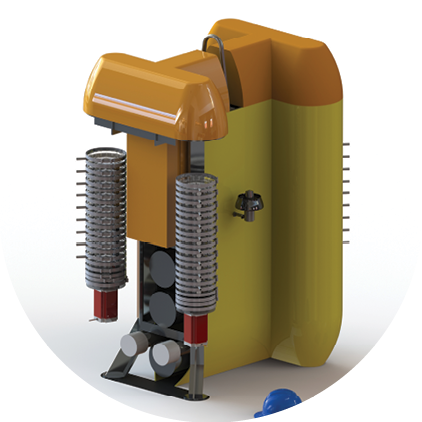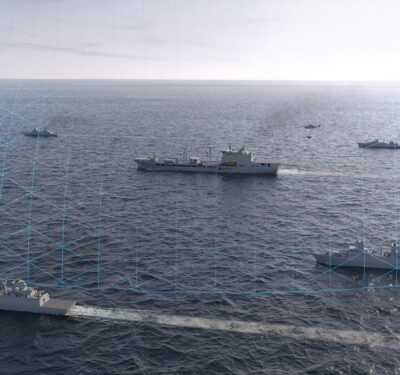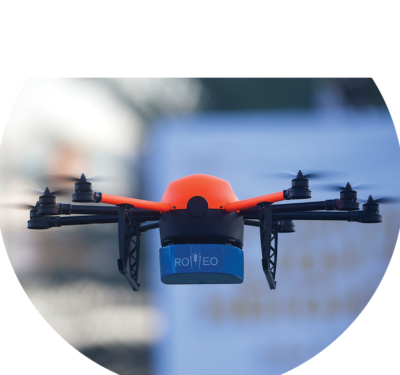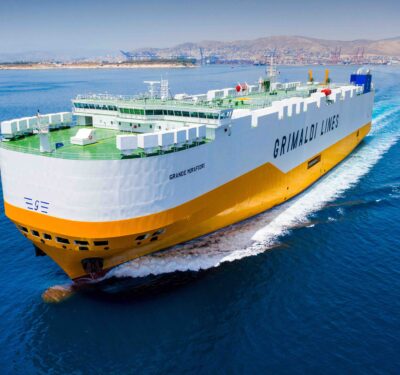
A new autonomous marine sampler could improve scientists’ understanding of the oceans’ biological underpinnings by slashing the manpower and funding needed to do broad biogeochemical surveys.
Clio, a vehicle developed at the Woods Hole Oceanographic Institution (WHOI), drops to the ocean floor after being lowered over the side of a survey ship. Then working autonomously, it rises through the water column, taking samples at predetermined depths. Each roughly 14-hour journey to the surface takes samples at the same depths, enabling the mapping of biological elements like DNA, RNA, proteins, enzymes, lipids, metabolites and metals associated with marine microorganisms.
“The hope is to have a vehicle that we can really use for large-scale ocean surveying and research—studying all kinds of biogeochemical and microbial processes,” said Mak Saito, a tenured associate scientist at WHOI.
Microbes are the foundation of the ocean’s nutritional web, Saito explained. “You need the algae, which are microbial communities, to grow and then work up the food chain to eventually have fisheries.”
Saito envisions a survey that would be the biological counterpart to the long-running GEOTRACES study of the trace elements and isotopes in the ocean associated with marine biogeochemical cycles.
“GEOTRACES is really a chemical survey program that’s focusing on a lot of really difficult-to-measure metals and micronutrients,” Saito told Inside Unmanned Systems. The goal, he said, is to move “from the purely inorganic to now looking inside the organisms and seeing what they are doing and who they are and how they are responding to their chemical environments.”

Doing such research, however, is particularly expensive. Research ships cost tens of thousands of dollars per day to operate, Saito explained, and the sampling is usually done, slowly, via a single wire.
“Currently we have to put pumps on the line and collect samples—or even bring water up from 1,000 m down or 2,000 m down,” he said. “All this water comes up and then you carry the water over to filtration machines and you filter it all—that can take hours. It’s a lot of work.”
If you run more than one wire at a time you run the risk that the ship will turn and the lines get tangled.
“So you are restricted, in sampling, to one operation at a time,” Saito said. “Clio is really designed to circumvent that bottleneck.”
Scientists will be able to lower Clio into the water and have it perform its survey while concurrently taking a separate set of samples using the wire system—all without fear of entanglement. This will enable researchers to, for example, perform a GEOTRACES and a biogeochemical survey at the same time.
Clio can also reduce cruise time. In the case of GEOTRACES cruises, the last one was 70 days long and about two thirds of it was station time, where the ship is stopped while the waters are sampled, Saito said.
“It reduces the station time by roughly half,” Saito said, “and then the cruise by roughly a third. You can save hundreds of thousands of dollars per cruise.”
To support those efficiencies Clio is specifically designed to be simple to work with, said Mike Jakuba, the project’s lead engineer at WHOI. “We really want to build a vehicle that ultimately will require only one person to operate—that’s pretty key to the overall objective of maximizing utility of ships transiting the ocean and doing other work in parallel with this vehicle.”
Clio is equipped with 32 easily accessible filters. To concentrate samples water is pumped through the filters—which can each be operated separately. Once a sample is collected, the filter is flooded with a product called RNlater, which stops cellular activity, preserving the sample ‘as is’ until it can be retrieved.
Designing an autonomous underwater vehicle (AUV) for vertical bio-sampling at depth has presented a number of challenges, Jakuba said. For example, there are limits on the types of materials that can be used.
“We’re not allowed to use any iron-containing alloys and try to avoid hydrocarbons—oils and so forth”—because iron and hydrocarbons can both be significant contaminants, Jakuba told Inside Unmanned Systems.
“Iron is a major limiting nutrient in the ocean—so not fertilizing the sample before you take it is a big deal. Hydrocarbon, similarly, can be broken down by microbes—again biologically reactive. We don’t want to feed them,” Jakuba quipped.
Finding a way for Clio to move up and down the water column, and to do so with business-smart efficiency, took effort as well.
“There are lots of ways to move vertically,” Jakuba said, “One is to change your buoyancy. That’s hard to do especially when you get very deep—buoyancy pumps become pretty challenging, ballast pumps become pretty challenging beyond, say, a couple thousand meters.”
The team didn’t want to use weights, which contain iron. Moreover, he said, “you have to carry them with you, which doesn’t support easy logistics.”
The team settled on having the AUV drive up and down with two built-in thrusters. To save energy that would otherwise have to be expanded while lingering at each sampling depth, they also chose to construct Clio so its compressibility would be as close as possible to that of water.
“Buoyancy depends on the density of the background fluid,” Jakuba said. “Water becomes more dense as you go deeper because it is, itself, compressible. The same volume at the surface, at depth its buoyancy will increase. So the vehicle becomes lighter, essentially, as it goes deeper—if it’s incompressible. If it’s compressible that affect is reduced. Ideally it would be just as compressible as water so its buoyancy wouldn’t change.”
The design team is using a variety of materials, some more compressible than others, so the overall compressibility of the vehicle is close to that goal. They are also taking very careful account of the vehicle’s buoyancy throughout the whole design process.
“Our mechanical design feeds directly into a simulation that estimates the amount of energy required to perform a dive,” Jakuba said.
The parts for Clio are currently on order and will be assembled over the winter with plans for an ocean test this summer.
“The July test will put the machine through its paces,” Saito said, to see if it can collect the samples they hope to collect.






